Main Street, Vineyard
Haven, MA: Centre
Street to Church Street
Site 30: Eagleston Block
The following is a history of the buildings and businesses that have
stood over the past century in the location of what used to be Oliver's
Paper Store, the A&P, Charlie Call's china shop, Mrs. A. T. Tilton's
dry goods store, and in recent years the Thrift Shop, on the west side
of Main Street in Vineyard Haven, Mass.
This is an unfinished draft! Do you have any memories of any of the
other people, places, businesses or events mentioned here? Or do you have
corrections, additions, or suggestions? Please contact Chris Baer
<cbaer@vineyard.net>
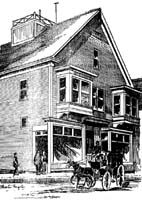 1891 illustration of
Eagleston's "Boston Store"
1891 illustration of
Eagleston's "Boston Store"
Stan Lair said: "The
next store was Aleta Tilton's - she was the wife of H. L. Tilton who ran
the drug store further up the street. She had a dry goods store there.
Later it was run by Charlie Call. Then it was an A&P store. It was
a gift shop under a few owners, and it is now the Thrift Shop."
This property was the southern portion of a tract of land owned by Isaac
Daggett until 1800 when it was sold to Leonard Merry, who in turn sold it
to Dr. Benjamin Trask in 1802. See Site #31
for more on these early pre-fire property owners.
In August 1888 this burned lot was sold to William W. Douglas
for $1300 by Sarah and Peter Sturges of New York City, and
in April 1891 Douglas sold the front portion of this empty lot for $800
to Allen P. Eagleston of Vineyard Haven. (Douglas retained ownership
of the lot in the rear.)

A. P. Eagleston's "Boston Store" (1891 - 1893)
In April 1891 the Gazette reported that "Several new buildings will
soon be erected. Mr. Eagleston and Mr. Coye have each purchased land north
of Mr. Douglas' store, known as the 'Trask lot,' and will erect two substantial
stores. The villagers are delighted that the empty space at the head of
Wharf street is so soon to be a thing of the past." In August 1891
the Gazette reported "Workmen began this week to break ground for the
foundation of the new store Mr. A. P. Eagleston, of the Boston Store, will
soon erect on Main Street" and that Eagleston was "about to erect
a large and commodious store on his lot, 35 feet front and 60 feet deep.
…The upper rooms will be used as a dwelling." An August 1891 ad
for Eagleston's "Boston Store" announced that they were "about
to build our new store. Will be ready for occupancy this fall. Summer visitors
will remember another season that The Boston Store will be situated directly
opposite the street leading to the Steamboat wharf…"
Eagleston's Early Years
Allen P. Eagleston (1855 -
1917) came to Vineyard Haven in the 1870s. He had entered the dry goods
business at the age of eleven, and at the age of eighteen had opened his
own business in Vineyard Haven. His dry goods store was on Main Street opposite
the Mansion House in 1876 (see Site #___), and he called it the "Vineyard
Haven Cheap Store," perhaps to differentiate it from the "Cheap
Store" in Edgartown run by L. C. Bliss. In 1879 Eagleston moved the
store one door north (next door to Hammond's barber shop, across Main Street
from what was then the Post Office. See Site #___.) In the 1880 Tisbury
census, Allen P. Eagleston was listed as a "dry goods merchant."
Eagleston was born in Salem, the son of Capt. John Henry
Eagleston of Salem (referred to in one article as "a well known sea
captain who commanded clipper ships in trade to the Orient and the Pacific
Islands") and John's third wife Hannah Norton (1832- ?; daughter of
Alfred and Hannah Norton) of Tisbury. Allen was the brother of Edward Eagleston
(a merchant and sometime partner of Allen) and James V. Eagleston (proprietor
of the Eagleston Inn in Hyannis.)
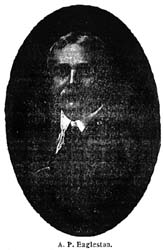 In February 1881 the
Gazette reported that "The Allen P. Eagleston Manufacturing Company
having closed up its business, R. W. Crocker Esq., has purchased the engine,
boiler &c. and proposes introducing steam into his harness making establishment…"
In 1882 Eagleston moved to Hyannis and purchased the dry goods business
of George L. Thaxter. He named his new shop "The Boston Store"
and maintained it until the spring of 1887 when he sold his business to
Mr. P. M. Crowell. He may have also spent time living in his hometown of
Salem during these years. In February 1881 the
Gazette reported that "The Allen P. Eagleston Manufacturing Company
having closed up its business, R. W. Crocker Esq., has purchased the engine,
boiler &c. and proposes introducing steam into his harness making establishment…"
In 1882 Eagleston moved to Hyannis and purchased the dry goods business
of George L. Thaxter. He named his new shop "The Boston Store"
and maintained it until the spring of 1887 when he sold his business to
Mr. P. M. Crowell. He may have also spent time living in his hometown of
Salem during these years.
A. P. Eagleston and his brothers Edward and James then
moved with their widowed mother to Atlanta, Georgia, where in 1888 they
opened the Eagleston Brothers dry goods store known as the "Bee Hive."
In October 1888 the Atlanta Georgia Cracker reported
(as reprinted in the Gazette): "[Eagleston]
began a new era in the success of his life, opening the popular and extensive
'Bee Hive' in Atlanta, which to-day is a household word with every lady
in the city and throughout the South. … As a business man, his equals
are few - superiors, none. It is said by many that no one crosses the thresholds
of the New York and Boston markets that buys or owns their goods cheaper
than Mr. A. P. Eagleston, the Prince of Buyers. His hosts of friends in
Atlanta wish him and his brother the most unbounded success in the conduct
of the magnificent and well-stocked 'Bee-Hive,' the headquarters for dry
goods, made so through a determination to lead all competitors in newness
of styles, reliability of goods and cheapness of prices."
Their Atlanta business evidently did not last much more
than one year. Allen and Edward returned to the island and in May 1889 opened
the Eagleston Brother Boston Store (See Site
#23). In 1890 Edward moved to Hyannis. |
 In October 1891 the Gazette reported
that "Mr. Eagleston's new store is fast nearing completion. On Monday
the large plate glass windows were put into position." Later that month
Allen Eagleston and his wife Mary secured a $1500 three-year mortgage from
Presbury Smith on this property. In November the Boston Store held a sale
"previous to our removal to the new store."
In October 1891 the Gazette reported
that "Mr. Eagleston's new store is fast nearing completion. On Monday
the large plate glass windows were put into position." Later that month
Allen Eagleston and his wife Mary secured a $1500 three-year mortgage from
Presbury Smith on this property. In November the Boston Store held a sale
"previous to our removal to the new store."
In mid-November 1891 the Gazette described the improvements on the "Trask
lot": "The south-east side is covered by a substantial block,
built by Mr. A. P. Eagleston, and will soon be ready for occupancy. The
upper rooms on the south and east sides are already occupied by the Government
as a weather bureau. Mr. Eagleston will use the first floor for his dry
goods business. This floor and the rooms already mentioned are finished
in hard wood, and it was through Mr. Eagleston's efforts that Government
has at last found more suitable quarters for business. The remainder of
the building is lathed and plastered, and is well adapted for offices."
The Boston Store held its grand opening on Nov. 28, 1891, with a sale
on "ladies and misses garments."
In December 1891 it was reported that young Charles Call was clerking
at Boston Store, and for the holidays Eagleston brought in extra clerks
Miss Annie Smith, Mrs. Nora Staples, Wm. Kidder, and Fred Luce.
In January 1892 the Boston Store advertised itself as a "Dry and Fancy
Goods store" selling "ladies' garments" and "dress goods."
In August 1892 the paper reported that Eagleston was making improvements
to his block, and that he was opening a furniture department in connection
with his dry goods business. Contractor M. C. Vincent was hired to remodel
the third floor of Eagleston Block for the new Boston Store furniture department.
In October 1892 it was reported that Miss Bessie Gould was clerking
at the Boston Store.
In March 1893 the Gazette commented on Eagleston's new signs which had
been painted by Frank E. Leach, and in May 1893 The Boston Store advertised
its 3rd Floor Furniture Department.
Sophronia H. Davis' Millinery Rooms (1891 - 1893)
In December 1891 the paper reported that Mrs. M. A. Newhavre had sold her
millinery business to Miss Sophronia H. Davis "who will commence
in the spring in Eagleston's new block." In October 1892 the paper
mentioned "Millinery at Miss Davis', Eagleston Block" and December
1892 of "Miss S. Davis' Millinery Rooms." In July 1893 Miss Davis
held a "closing out sale" of her millinery at her store in the
Eagleston Block, and in November she moved her millinery goods to Mrs. David
Butler's home on Spring Street.
E .G. Eldridge's Real Estate and Insurance Agency (1892
- ?)
In September 1892 it was reported that Mr. E. G. Eldridge of Cottage
City had leased an office in Eagleston's block, and worked here two days
per week as a real estate and insurance agent.
The Closing of Eagleston's Boston Store
In June 1893 the Gazette reported that The Boston Store was closing, and
that A. P. Eagleston was combining his business interests with his brother
Edward L. Eagleston in Hyannis. The Boston Store held a "closing out
sale" of dry goods and furniture.
The Boston store officially closed on Aug 18, 1893. In October, Eagleston's
employee Louis Rosskoff opened his own dry goods store in Mrs. L.
T. Norton's former worsted store (see Site #___.) The same month A. P. Eagleston
and his brother Edward opened a new furniture store in Hyannis. Edward Eagleston
had been the proprietor of the New York Store in Hyannis since the fall
of 1890.
In July 1894 Allen P. Eagleston and his wife Mary sold this lot to Hyannis
widow Hannah Eagleston (probably his Vineyard-born mother), and on the same
day Hannah Eagleston sold the lot back to Mary L. Eagleston (Allen's wife.)
It's unclear what the purpose of these transactions were. Likewise, in April
1907 A. P.'s wife Mary L. Eagleston "of Hyannis" sold this lot
to Allen's brother Edward L. Eagleston of Hyannis, and on the same day Edward
Eagleston sold the same lot to Allen P. Eagleston of Hyannis.
Eagleston did not stay out of business in Vineyard Haven long. By 1894
he had opened a new dry goods store ("The New York Store") elsewhere
on Main Street (see Site #___.) Meanwhile, the brothers' furniture business
in Hyannis existed until at least 1907, having suffered a devastating fire
in 1905 and rebuilt.
In February 1910 Allen P. Eagleston sold this lot for the last time to
William G. Manter.
In his later years, Eagleston became involved in the movie theater business,
including the purchase of the Capawock (see Site #9) and the establishment
of the Eagle Theatre in Oak Bluffs. He died in 1917, and in 1920 his widow
Lillian Eagleston married George W. Judkins. They continued to summer on
the island as late as 1928.
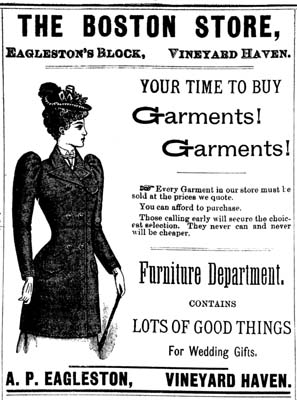 January 1892
ad
January 1892
ad
The U.S. Weather Bureau Office and Telegraph Exchange
(1891 - c. 1903)
The Telephone Exchange (1891 - 1896)
Gratia Harrington, in a 1967 article for the Gazette,
wrote:
"On the right-hand side [of this building] was the official who received
weather reports and here also was the telegraph office. From the roof of
the building flew the weather signal flag. I can remember seeing the red
and black flag that was a storm signal, but never remember seeing two of
these flags flying which warned of a hurricane."
In September 1891, before Eagleston had even moved his own store into
the new building, the Gazette reported that "The U. S. Signal Service
office will be removed from the Mansion House about Oct 1st, to the
business building of Mr. A. P. Eagleston, now nearing completion on Main
street." The island's Signal Service operator at this time was William
Washington Neifert (1865-1951). In 1893 Neifert was described as the
local "Observer" for the Weather Bureau, U.S. Dept. of Agriculture.
Neifert's obituary in the Gazette states:
"As a resident of Vineyard Haven, Mr. Neifert was observer for the
federal weather bureau…. Mr. Neifert was a man of warm personality
and much philosophy; he was a great reader, and he liked to delve into
the byways of history and of the family lore of the Vineyard. He was of
first rank in the profession of meteorology…. He never lost the spirit
of inquiry or awareness of the times around him. … Mr. Neifert was
born in Rush Township near Barnesville, Schuylkill County, Pa., on Jan.
27, 1865, son of the late William and Lucinda (Lindner) Neifert, the youngest
of nine children."
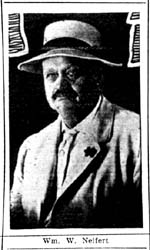 Neifert enlisted as a telegraph
operator in the United States Signal Corps in 1885. In 1886 Neifert was
chosen, because of his ability to use a heliograph and his knowledge of
meteorology, to command a party of "heliograph men" to assist
in the "Apache War" in the Arizona mountains during the campaign
to capture Geronimo. The following year he was assigned to manage a telegraph
office in Fort Reno in the "Indian Territory" (which was to become
"Oklahoma" during his stay there.) After short periods in Texas,
Virginia, and Philadelphia, he was sent to Vineyard Haven in May 1890 to
operate the cable which had been laid to the island by the government in
1885. Here he was discharged from the Army and appointed an observer for
the Weather Bureau in the Department of Agriculture. His first office was
in the Mansion House (see Site #15), before moving to the Eagleston Block
in 1891. In April 1891 Neifert married Myra Fisher White of Vineyard Haven
and New Bedford.
Neifert enlisted as a telegraph
operator in the United States Signal Corps in 1885. In 1886 Neifert was
chosen, because of his ability to use a heliograph and his knowledge of
meteorology, to command a party of "heliograph men" to assist
in the "Apache War" in the Arizona mountains during the campaign
to capture Geronimo. The following year he was assigned to manage a telegraph
office in Fort Reno in the "Indian Territory" (which was to become
"Oklahoma" during his stay there.) After short periods in Texas,
Virginia, and Philadelphia, he was sent to Vineyard Haven in May 1890 to
operate the cable which had been laid to the island by the government in
1885. Here he was discharged from the Army and appointed an observer for
the Weather Bureau in the Department of Agriculture. His first office was
in the Mansion House (see Site #15), before moving to the Eagleston Block
in 1891. In April 1891 Neifert married Myra Fisher White of Vineyard Haven
and New Bedford.
Although grocer Stephen Luce had installed the first telephone in Vineyard
Haven in 1881 next door (see Site #29), and
after the fire had managed a telephone system in his new store until 1886
and again after 1896 (see Site #32), for
seven years the town's telephone system operated out of the second floor
of this building. According to a 1938 Gazette article on telephones, "The
first central office was in a room at the head of Union Street, in Vineyard
Haven. This office was established about 1890 [sic.] when increasing demand
made it necessary to have a main switching station and several circuits
controlled by an operator." In October 1891 the Gazette was reported
that a telephone connection to Gay Head was now in operation at the new
office of the U.S. Signal Service.
In February 1893 the Gazette announced "Telephonic Communication
with Mainland." According to the paper (including 1943 and 1951 retrospective
articles), George A. Hough Sr., city editor of the New Bedford Standard
in New Bedford, and Weather Observer Neifert at Vineyard Haven had spoken
on long-distance telephone - the island's first-such connection. Neifert
had proposed the experiment to attach the government wire in his office
to a long distance transmitter, while the telegraph operator at Buzzard's
Bay connected the telegraph wire to the Southern Massachusetts Telephone
Company's metallic circuit. The paper reported, "For the first time
the voice of a man in New Bedford was heard on the Island." Railroad
operator Mr. Bowley in Buzzards Bay assisted by connecting one wire of the
New Bedford metallic circuit with the telegraph line from the Vineyard.
William W. Wagner of the New Bedford exchange also assisted. The paper went
on to explain that the U.S. Signal Service telegraph line over which the
conversation was held extended overland from Vineyard Haven to Gay Head,
where it connected with a submarine cable crossing Vineyard Sound to Pasque,
then to Naushon, then to Woods Hole, and then to New Bedford via Buzzards
Bay and Tremont.
The Gazette also recalled in a 1951 article, "Mr. Neifert must have
been a commanding figure when he came here, for he was six feet two in height
and built accordingly.… For six and a half years Mr. Neifert was in
charge of the Weather Bureau station here, and during the Spanish American
War he had full responsibility for military telegraph and sea coast cable
lines to the Island."
While maintaining his position at the telegraph office and as weather
Bureau observer, Neifert evidently also ran a small retail business on the
side. In April 1894 he advertised electrical supplies with "telephone
and call bells a specialty" as well as "foreign and domestic postage
stamps." In January 1895 he also advertised "telephones and call
bells put up."
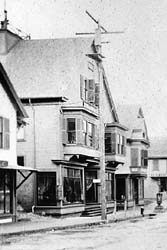 c. 1891-97
c. 1891-97
Gratia Harrington said:
"I can remember the first time I ever listened to a telephone, oh
I suppose 1895, something like that. I don't know how long they had had
them. In that building where the Thrift Shop is, in the center of the building,
you went in and there was a big staircase that led right upstairs. The
store was all around it, but it led upstairs, and upstairs on one side
was a man who had charge of the weather. They used to have signals, you
know, for what kind of weather they were going to have. And also so this
man had a telephone. And he said to me, he got a message, someone rang
him on the telephone, and I was so interested. He said, 'Would you like
to listen too?' And I said, 'Yes!' So he let me listen and you see it was
somebody in New Bedford talking to somebody in Nantucket about some fish.
It wasn't very interesting, but still it was very exciting. And across
the hall from him was the customs officer. We used to have a customs officer
here. Seems strange, doesn't it now that we would have it. But I think
that must have been about, oh 1896 perhaps."
In November 1896 the Gazette reported that "The Telephone Exchange
has moved from its room over Luce Bros.' store into Mr. Stephen Luce's store,
corner Church and Main streets." (See Site
#32.) However, the telegraph office evidently remained at this location.
In January 1897 the Gazette reported that government weather observer
Neifert had been ordered to Nantucket to take charge of the station there.
From there he was transferred to Boston in 1902, and from Boston to Hartford.
He continued to visit the island on occasion. W. W. Neifert died in March
1951 at the age of 81.
According to NOAA's 1933 publication, Weather Bureau
Topics and Personnel:
"Mr. William W. Neifert was retired at the termination of April 30,
1933. He was born at Barnesville, Pa., on January 27, 1865. He enlisted
in the Signal Corps November 27, 1885; after the usual period of instructions
at Fort Myer he was transferred to Fort Bowie for a short time; later he
served as assistant or official in charge at Fort Reno, San Antonio, Palestine,
Brownsville, Norfolk, Philadelphia, Vineyard Haven, Nantucket, Boston,
Hartford, Dayton, and Binghamton. At the time of his retirement, he was
in charge at Binghamton."
In February 1897 weather observer Max Wagner was appointed to
take Neifert's place at the station here. The 1897 Vineyard Haven directory
lists Wagner as the operator at the Main street Telegraph Office. (It also
lists John W. Parker as a "telegrapher" - was he also employed
at this office?)
About 1900 the two telegraph companies, Postal Telegraph Co. and Western
Union Telegraph Co., jointly bought the telegraph lines from the government
who up until then had owned the cables to the mainland. The two companies
merged to become the Martha's Vineyard Telegraph Company. This was also
the year that a telephone cable to the mainland went into operation, ending
the experimental use of piggybacking telephone calls on the telegraph lines.
The 1900 Vineyard Haven census lists 29-year-old Carleson(?) J. Doherty
as the "telegrapher" at the U. S. Government Weather Bureau, as
well as George C. Golart (1874- ____) as the "clerk" at
the U.S. Weather Bureau. In June 1902 Carl Kruse hired by telegraph
office, and in September 1902 Marston Flanders was employed as a
messenger by the Western Union Telegraph Company, whose headquarters continued
to be in the "Eagleston Block." In May 1903 the Gazette reported
that Mr. Chapman from Provincetown was the new telegraph operator, and that
"Miss Josephine Wright, who has been in charge of the telegraph
station about a year has removed to Woods Hole as a permanency."
By July 1903 the Martha's Vineyard Telegraph Company had moved its Vineyard
Haven office into Lane's Block (see Site #5.) Its General Manager was listed
as H. G. Haddon of Woods Hole. In September 1903 a "for rent"
ad appeared: "Eagleston Block, Vineyard Haven - for rent, front room
and connecting room, formerly used by the Telegraph Co. Overlooks the harbor.
Apply to Miss J. Annie Smith at the Eagleston Shop."
The Customs Office (1891? - after 1913?)
The "Customs house" was located here by the mid-1890s, and
had probably moved here in 1891 when the other governmental offices (the
weather bureau, telegraph, and telephone offices) first moved in. Capt.
Lorenzo F. Luce (1838-1909; son of Obed Luce and Johanna Davis of Edgartown)
was appointed the deputy customs collector in August 1890, and after his
death Howes Norris Jr. (1867-1937) became the next Vineyard Haven
customs officer. Up until this time the main office had been in Edgartown
and the Vineyard Haven office was a branch office, but in 1913 the Edgartown
office was abolished and Norris was promoted. The Customs Office was later
moved to the Luxemoor building behind the bank. (See Site #1). When the
Luxemoor building was moved in 1922 to Five Corners, Norris and his office
moved with it. In 1928 the Customs office returned to Main Street - see
Site #11. (Before the fire, the Customs House had also been on Main Street
- see Site #25.)
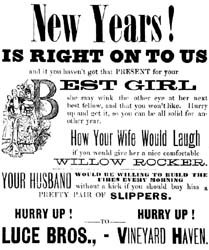 Luce's Bros.'
Second Store (1893 - 1908)
Luce's Bros.'
Second Store (1893 - 1908)
Gratia Harrington, in a 1967 article for the Gazette,
wrote: "As the largest store on Main street
it was considered a very fine and ambitious undertaking. Capt. Barnard
Luce was the owner, another whaling captain, of short and stocky build.
Several of the whaling captains whom I remember were small men. They must
have had a great deal of force of character to rule their ships to the
extent that whaling captains were forced to do.
"The Vineyard people did most of their buying on the island and a
dry goods store had to carry a varied and large stock. Captain Barnard's
fine big store was very popular and well patronized. As one entered the
building, the entrances to the store were to the right and left, and in
the center was a broad staircase leading to offices on the second floor.
On the left side at the front, its windows commanding a good view of the
harbor, was the U.S. Customs office with Capt. Lorenzo Luce as customs
officer."
Gratia Harrington, in the book The Captain's Daughters,
said:
"Haines' Gift Shop, where Union Street comes into Main, was a big
store in the old days. It was built [sic.] by Captain Barnard Luce, a retired
sea captain, and made into a dry goods store. There were no ready-made
clothes, of course. In the middle of the store building there was a stairway
to the second floor. On one side of the upstairs was the telephone. Father
was a friend of the telegrapher, whose job at that time was most important.
He offered to let me listen in, and I did. A man in Nantucket was talking
to a fish dealer in Woods Hole. Terribly exciting! It was run by Capt.
Lorenzo Luce, a great uncle of Stephen Carey Luce, but no relation to Barnard
Luce."
In September 1893 the Gazette reported that "Luce Bros., dry goods
dealer, will soon occupy the store lately vacated by A. P. Eagleston."
Later that month they reported "Luce Bros., dry goods dealers, are
now occupying the store recently vacated by A. P. Eagleston, and also the
store occupied by them since rebuilding in consequence of the fire in 1893."
(See Site #8.)
The Luce Brothers store on the other side of Main street sold gentlemen's
furnishings, boots and shoes; this new store, leased from Eagleston, sold
"dry and fancy goods," mostly for women, as well as furniture.
That fall the Luce Bros. printed enormous advertisements in the Gazette
for their new store. They retained the name "The Boston Store"
for several months.
The Luce Brothers, Capt. Barnard Luce (1832 - 1898) and Presbury
Sherwood Luce (1852 - 1937) were the oldest and youngest sons of Tisbury
shoemaker Timothy Luce (1806 - 1889) and his wife Joan (Norton) Luce. Capt.
Barnard Luce specialized in dry goods, and Presbury in shoes and clothing;
Bernard managed the store at this location, and Presbury the store across
the street. It is likely that Barnard's son Dean Sherwood Luce (1876-)
also worked at this store from a young age, as he later took over the business.
Although it's not known who worked at which branch of the store, Mrs.
Thankful Tilton and Mr. Josiah Bodfish were known to have worked
for Luce Bros. in 1889, as did Lillian May Hillman in 1895 and Miss
Bessie Gould during 1895-9.
In November 1893 the Luce Bros advertised hair mattresses; and in January
1894, furniture and ladies' and misses' garments. In 1897 they billed the
town for the purchase of some clothing.
In January 1894 and January 1895 a business calling itself "The
Bostonian" advertised "Piano, Organ and Sewing Machine Parlors"
in Eagleston Block.
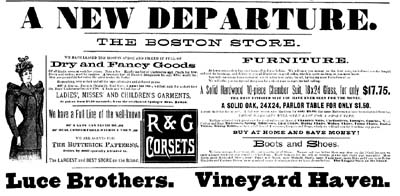 October 1893 ad
October 1893 ad
 Dean S. Luce
& Co. management (c.1897 - 1908)
Dean S. Luce
& Co. management (c.1897 - 1908)
By December 1897, Dean S. Luce was helping manage the business
at this location. Luce was born in Holliston, the son of Capt. Barnard C.
Luce and the grandson of R. W. Coffin (see Site
#27), and had come to Vineyard Haven as a child.
In 1894 and 1895 Luce had been listed as a student at Phillips Academy
at Andover, and in May 1897 as a student at Harvard. In December 1897 the
paper referred to him as "a certain Harvard ex-'00." According
to a 1950 article, Dean had entered Harvard with the class of 1899, but
had to leave at end of his sophomore year after his father's death to take
over management of the store. Three years later he entered Harvard Medical
School, and commuted between Cambridge and Vineyard Haven to manage the
store.
In 1898 Barnard Luce died, and in October of that year the paper reported
that "Luce Brothers have consolidated their two stores, occupying the
larger one known as the Eagleston block."
In December 1898 the paper reported that Helen Tilton was clerking
at Luce Bros. for the holiday, and in January 1899 that Miss Bessie Stanton
had resigned as a clerk at Luce Bros.' store and that Miss Mabel Bodfish
was clerking in Luce Bros. In February 1899 the paper reported that Miss
Bessie Gould was clerking at Luce Bros., but in May 1899 that Miss
Emma Chadwick had been hired as the summer clerk, replacing Miss Bessie
Gould. In June 1899 Emma Luce was clerking for Luce Bros for the
summer. In March 1900 Miss Bertha Cook took Miss Bessie Gould's place
as a clerk at Luce Bros.' dry goods store.
Luce Bros. clerk Bertha Waterman Cook (1862-1917) was born in
Provincetown, the oldest daughter of Capt. Harvey S. and Charlotte Cook,
and the sister-in-law of Dr. Thompson who had his office upstairs from the
store (see below). Her obituary states, "Miss Cook was a very simple
and quiet in her tastes, her attractive home and the culture of rare plants
being companionship for her in large measure. Her lovely garden was a great
delight not only to herself but to hundreds of passers by." She died
in 1917 at the age of 62.
In March 1900, the Gazette reported that Presbury Luce was reopening
his old store across the street at Site #8, but that Dean Luce was to continue
to carry on the dry goods business here. In April 1900 it was reported that
Dean Luce was teaching in Cottage City. Dean Luce was listed as a 24-year-old
dry goods merchant in the 1900 census, living with his widowed mother and
his maternal grandparents. The 1901 town report recorded that Dean S. Luce
had sold clothing and "sundries" to the school the previous year
(and, notably, listed "Luce Bros." separately for the purchase
of mattresses and shoes.)
By January 1901, Dean Luce was attending Harvard Medical School, and
managed his store from afar. In March of that year the Gazette reported
that he was in town "looking after the interests of his business."
He was again listed as a medical student at Harvard in July 1902 and May
1903. He interned at the Long Island Hospital, received his M.D. degree
in 1904, and began his practice in Canton in 1905. In February 1905 Luce
married Ethel May Bense of Canton, the daughter of William H. Mense of that
town, and in April and May of that year there were references in the paper
to "Dr. Dean S. Luce of Canton, Mass."
In April 1902 the Gazette reported that Mrs. Luella Tilton was
clerking at Dean Luce's store during Miss Bertha Cook's absence, and in
April 1903 that Miss Ethel Luce was employed as a clerk at the store
of Mr. Dean Luce. In June 1905 the paper reported that Miss J. Annie
Smith had taken a position with "Dean S. Luce & Co." (Smith
had formerly worked at the "Eagleston Shop.")
The 1906 Tisbury town report lists payments made to Dean S. Luce &
Co. for providing articles for the town's poor, as well as desks, chairs,
and a letter press stand for the town.
In January 1906 Mr. William Barry Owen rented an office in the
Eagleston Block for the management of his poultry business.
In December 1906, Dean S. Luce & Co. were advertised as dealers of Luxemoor
Leather products, made in Owen's short-lived factory behind the bank.
The 1907 directory lists D. S. Luce & Co. as a dry goods store, and
Bertha W. Cook as a clerk working there. ( The same directory lists "Luce
Bros. (P. S. Luce)" as a furniture store across the street.)
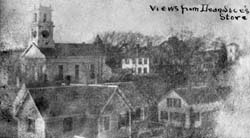 Snapshot taken by
Dorris Hough from the roof of Dean Luce's store, looking northwest toward
the Methodist Church, c. 1904-5.
Snapshot taken by
Dorris Hough from the roof of Dean Luce's store, looking northwest toward
the Methodist Church, c. 1904-5.
Dr. Dean S. Luce of Canton continued to make occasional business trips
here, and in September 1907 the paper printed a rumor that "the long
established firm of Dean S. Luce & Co. is soon to be dissolved and the
business to change hands." Dr. Luce's uncle Presbury Luce finally closed
this branch store and moved all of the family business interests back across
the street by April 1908, and in September 1915 Presbury S. Luce ("doing
business under name Luce Bros.") sold everything to Holmes Luce &
Co. of Boston, and retired.
In January 1908 the Gazette reported that "The 'Driving Association'
a gentleman's club, has taken a large room of Mr. Eagleston over the present
Dean S. Luce & Co.'s store, where it will hold business meetings."
Dr. Dean S. Luce spent the rest of his life as a resident of Canton,
Mass. In December 1950, the American Medical Association named Dr. Luce
"Family Doctor of the Year" at their meeting in Cleveland. Dr.
Luce died in April 1953 at the age of 77.
The Dentists' Offices
Walter Renear said: "The
window that bulges out - the dental chair was right in the middle of that
window. Supposedly the view from the window would distract you. There must
have been Thompson - Watkins - Lynch - at least three, maybe more, dentists.
It must have been an ideal dentist place!"
"There were several dentists in this building here. There was a stair
that goes up the - still does - goes up the side of the building? You look
out from the street, you find that set back slightly there's a door that
goes upstairs. It's still there. There were two or three dentists up there,
including, the last one I recall was Dr. Lynch. Dr. Lynch also was a competing
undertaker with my father. Well, anyway, when Dr. Lynch didn't have any
business, any customers, he used his drill to carve wooden buttons. Make
wooden buttons and make holes in them, and carve them. That was Dr. Lynch.
He actually lived in Oak Bluffs, just over the bridge on the left hand
side."
Dr. Chase (1895-?)
In May 1895 Dr. E. H. Chase, dentist, advertised his services in
his summer office at the Eagleston Building as well as a second office in
Oak Bluffs. He left in September, but in July 1897 the paper reported that
Dr. Chase was to resume practice here, although it's not known whether he
returned to this building.
Dr. Thompson (before 1899 - after c. 1915)
In November 1899, January 1900, and January 1901, Dr. Edwin S. Thompson,
dentist, advertised at Eagleston Block. In November 1905 he announced his
wedding engagement, and the paper noted that he had "made his home
here for several years." The 1907 Vineyard Haven directory lists Dr.
Thompson, dentist, at his office on Main street opposite Union street, and
his office hours were given as 9 to 12 am and 1 to 5 pm. Dr. Thompson may
have moved his office into Lane's Block (Site #4) in later years.
Dr. Edwin S. Thompson M.D. (1872-1944) was born in South Portland, Maine,
the son of Edwin Thompson and Ann E. Gikles of Tisbury and Dartmouth. He
graduated from the Harvard Dental School and then came directly to Vineyard
Haven where he was a practicing dentist for about thirty-five years. He
married Clara H. Cook (c.1879-80 - 1948), the daughter of Capt. Harvey S.
Cook and Charlotte N. Hooton, and the younger sister of Bertha Cook who
worked downstairs for the Eagleston Brothers. Dr. Thompson served as selectman
for nine years, and as one of the food administrators in the first world
war. In his retirement, Dr. Thompson and his wife established the Menemsha
Inn in Chilmark. He died in Medfield in 1944.
Dr. Lynch (? - ?)
Dr. Paul Lynch (c.1874-5 - 1938) reportedly had an office here
for a few years until he moved into Lane's Block (Site #4).
Dr. Watkins (1936 - 1940)
In July 1936 the Gazette reported that two office rooms on the second floor
of this building (by this time known as "Call's Block" - see below)
had been rented to Dr. H. Eugene Watkins, a dentist, of Worcester
and Vineyard Haven. He was still at this location in February and July 1937.
In November 1940 Dr. Watkins moved his dental parlors from Call Block to
Lane Block across the street, into the former offices of Dr. Paul Lynch.
Bob Renear recalled that Dr. Watkins later moved to
Lane's Block. He said:
"I remember going to him. He used to have a hobby of carving wood.
People were in the waiting room and they'd hear this waaaaaahaahhh. He's
there grinding away at a piece of wood. …He made little animals or
whatever."
Sam Issokson on Dr. Watkins:
"He used to live across the street from me, on Centre Street. He was
a nice old gentlemen. He went over to Lane's Block. I remember once one
time we were playing baseball, and they hit the ball and it smashed his
window in the basement. I tried to put a piece of glass in and the window
broke. I got it fixed somehow, I don't remember exactly how. He was okay!"
 W. E. Godfrey's Men's Clothing
Store (1908 - 1911)
W. E. Godfrey's Men's Clothing
Store (1908 - 1911)
In March 1908, Wilfred E. "Fred" Godfrey (c.1874-5 -
?) printed a "Special Announcement" in the Gazette stating that
he was about to move his store into the Eagleston Block. (See ad, right.)
Since 1902 Godfrey had operated a men's clothing store two doors down (see
Site #28). In April 1908 the Gazette reported
that "Mr. W. E. Godfrey has moved to the store formerly Dean S. Luce
& Co.'s, and Mr. Presbury S. Luce has moved his furniture department
into the Lane block." In May 1908 the Gazette printed another "Special
Announcement" advertising "W. E. Godfrey, One Price Clothier,"
at the Eagleston Block. Godfrey's firm sold suits and hats, and Maurice
J. Dahill (c.1852-3 - ?) was employed as his "custom tailor."
In October 1908 Godfrey's ran an advertisement for suits, and in November
"W. E. Godfrey, The Vineyard Clothier" opened a branch store on
Main Street in Edgartown. Godfrey ran advertisements for men's and boy's
clothing, gent's furnishings, and small wares in both of his stores during
1909. In February 1910 Godfrey advertised clothing, furnishings, dry goods,
and shoes at his Main Street Vineyard Haven store only, but by April 1910
Godfrey was advertising both stores again.
Wilfred E. Godfrey is listed in the 1910 census as a 35-year-old retail
merchant of men's clothing, together with his wife Nell, their six-year-old
son Elbert, and his mother Lucy.
In February 1910, A. P. Eagleston of Hyannis sold this property to William
G. Manter of Tisbury. The same month, William G. Manter sold the property
to Josiah P. Bodfish, and the Gazette reported that the Eaglestons
had sold to Bodfish the block "where the Customs house is located and
stores and offices." In July, Godfrey printed an enormous advertisement
declaring "Building Sold Over Our Head." He stated that the store
had been sold to his competition even though Godfrey held a lease from A.
P. Eagleston which was good until March 1, 1911. He added that this was
"the second time in the history of our business in Vineyard Haven that
the same party has bought the building which we occupied." (See Site #28.) A rumor was reported that an unnamed
Vineyard Haven man was planning to build them a new store.
M. J. Dahill continued to be listed as Godfrey's "custom tailor,"
and in September 1910 W. E. Godfrey continued to advertise dry goods, clothes,
and furnishings, at both Vineyard Haven and Edgartown locations.
In January 1911 it was reported that Godfrey had bought Harry Castello's
block of stores on the corner of Main and Church Streets, and stated that
when his lease expired he planned to move his business into the corner store
(see Site #33.) In the meantime,
he temporarily moved into "the old postoffice" in Lane's Block
(see Site #4.) Godfrey closed his Vineyard Haven store and left the island
in 1914, and he was reported as a resident of Bridgewater during the 1920s.
(His father Capt. Z. B. Godfrey continued in business in Edgartown until
at least 1924.)
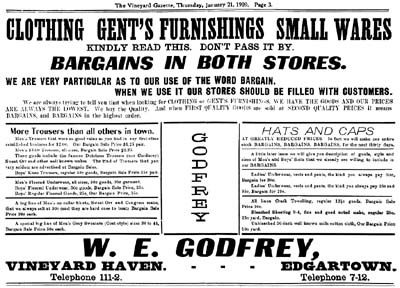
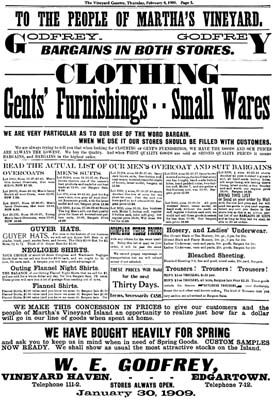

 Josiah P. Bodfish's
Dry Goods Store (1911 - 1912)
Josiah P. Bodfish's
Dry Goods Store (1911 - 1912)
Joseph Allen wrote: "Josiah
Bodfish was a very large man who conducted a dry goods store in Vineyard
Haven. When business was slack, he would sit in on of his display windows
in a large, comfortable chair, and crochet lace. He was known as an expert
lace-maker."
In January 1911, the Gazette reported that Josiah P. Bodfish,
who had just bought this property, was moving his dry goods store into his
recent purchase "where Mr. Godfrey now is." Since 1907, Josiah
Parker Bodfish (1854 - 1913) had managed the store two doors to the south
- see Site #28.
In January 1911 the Gazette made a reference to the "good appearance"
of Bodfish's new store, although the paper also noted that "Bodfish
[is] not in good health."
By October 1912 Bodfish had closed his store due to his failing health.
He died in November 1913 of stomach cancer at the age of 58. His obituary
in the Gazette called Bodfish "our leading dry goods merchant,"
and The New Bedford Evening Standard noted in his obituary: "Failing
health…obliged him to retire about one year ago [1912.] He was esteemed
for his business integrity, for his gentleness and courtesy."
Bodfish's widow, Mrs. Lucy P. Bodfish, inherited the property.
 c. 1915
c. 1915
Mrs. A. T. Tilton's Dry Goods Store (1912 - c. 1928)
In October 1912 Mrs. Aleta T. Tilton (wife of plumber Herbert
L. Tilton of Site #25) reported to
the town her intention to move into "the store recently occupied by
Josiah P. Bodfish." (In September 1910 she had bought the stock and
fixtures of Mrs. M. A. Place's business, and until 1912 she had been the
proprietor of a "dry and fancy goods business" in a store in the
north end of Lane's Block - See Site #4.)
Mrs. Aleta Thomas (Robinson) Tilton (1870 - 1933) was born "Hannah
Rose Crosby" in North Orland, Maine. She came to the Vineyard at the
age of three, and in March 1873 she was legally renamed "Aleta Thomas
Robinson." She was raised by Tisbury mariner Thomas M. Robinson and
his wife Laura Crosby of Edington Maine. (Perhaps one of Aleta's birth parents
was a near relative of Laura's? Aleta's 1933 death record also mentions
a sister Laura Mumler of North Orland, Maine.) Thomas appears as a "seaman"
and Laura as a "tailoress" in the 1865 Tisbury census. Thomas
died in January 1876, and young Aleta was raised by her widowed mother.
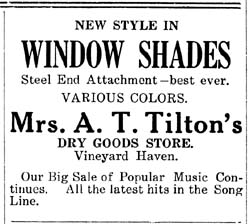 The 1920 Tisbury census
lists the 49-year-old Aleta T. Tilton as a retail dry goods store merchant
with her husband, "druggist" Herbert L. Tilton. In July 1925 Mrs.
Tilton advertised sheets and pillow cases.
The 1920 Tisbury census
lists the 49-year-old Aleta T. Tilton as a retail dry goods store merchant
with her husband, "druggist" Herbert L. Tilton. In July 1925 Mrs.
Tilton advertised sheets and pillow cases.
Connie Leonard said: "Next to Mr. Tilton's
hardware store, right across that little pathway that goes up there across
from where the Thrift Shop is was Leta Tilton's dry goods store. She was
the wife of Herbert Tilton that ran the Tilton's Drug Store. She had a
nice dry goods store there. And then later, when she retired, Charlie Call
took it over and he sold dishes and all sorts of stuff."
Rose Gouveia said: "Where
the Thrift Shop is today, when I was a little girl that belonged to Aleta
Tilton. And it was a dry goods store. You bought material by the yard and
thread and patterns and yarn, everything in there."
In March 1926 the first floor of the building was divided into two stores,
and Mrs. Tilton's store, which previously had filled the entire floor, now
occupied only half its former space. The Gazette wrote, "Mrs. Tilton
will continue in business in one part, which has already been redecorated
and fitted." Charlie Call's new store now occupied the other half of
the storefront (see below.) Throughout 1927, Mrs. A. T. Tilton continued
to advertise her "dry and fancy goods."
In February 1928 Mrs. A. T. Tilton formally opened her new dry goods
store next door (Site #29). She also advertised
a branch store in Edgartown.
 c. 1915
c. 1915
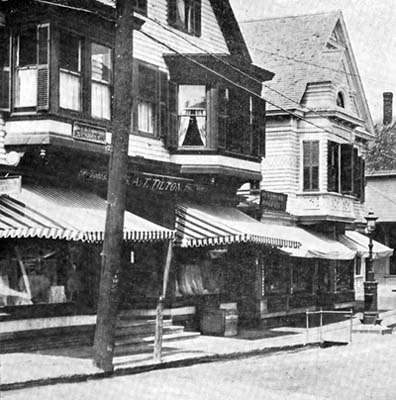 Mrs.
A. T. Tilton's and L. E. Briggs' stores c. 1915
Mrs.
A. T. Tilton's and L. E. Briggs' stores c. 1915
 A collection
of Mrs. Tilton's 1924 ads from The Vineyard Magazine
A collection
of Mrs. Tilton's 1924 ads from The Vineyard Magazine
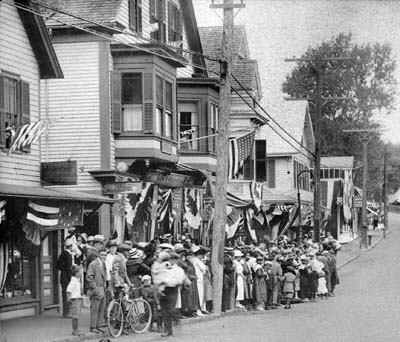 Circa 1913-1919. Israel
Issokson is the man with the cigarette standing behind the bicycle.
Circa 1913-1919. Israel
Issokson is the man with the cigarette standing behind the bicycle.
 Charlie Call's China
Shop (1926 - 1937)
Charlie Call's China
Shop (1926 - 1937)
In March 1926 the Gazette reported that "Charles F. Call
has recently completed the alteration to his Main street store building
by which the first floor, formerly occupied by Mrs. A. T. Tilton, is now
divided into two very pleasant and attractive stores. …The other half
of the building will be occupied by Mr. Call, who will carry a line of hardware
and house furnishings."
Charles Francis "Charlie" Call (1877-1957) was born in Tisbury,
the son of carpenter Charles Call of Pittston, Maine and his wife Alice
C. Luce, who was the daughter of grocer Warren Luce of Tisbury (see Site
#35.) The elder Charles Call died when young Charlie was not yet three years
old, and in 1886 Alice married Tisbury laborer Augustus H. Chesborough.
Charles' older brother Wilbert took over their grandfather's grocery (Site
#35), but by 1900 Charlie had become a plumber. By 1909 he was advertising
as an Edgartown plumber, and the 1910 Edgartown census lists 32-year-old
Charles Call as a plumber and tinsmith. In 1910 he married Lina Davis.
In July 1926 the Gazette admired a model schooner displayed in the window
of "Call's China Shop," and in December 1926 an ad appeared for
"Call's Toy Store." In April 1927 the 'Round 'Bout Tisbury column
mentioned that there were "so many teapots, coffee pots, and pitchers
in his store that it makes a person thirsty to look at them." In April
1927 the paper mentioned a radio cabinet in Call's store built by Maurice
Belain of the Tisbury High School carpentry course, and in May 1927 that
new gold letters had been put on Call's window. In July 1932 the 'Round
'Bout Tisbury column referred to Main Street merchant Charlie Call "with
the invariable cigar."
In November 1929 it was reported that Mrs. John Palmer was clerking
at Mr. Call's store, and in December 1930 that Miss Pearle Sears
was clerking at C. F. Call's store through Christmas.
| What did Call sell?
July 1926 - kitchen hardware, bedroom rugs, toys
November 1929 - toys
April 1930 - bathroom fixtures
July 1930 - Kelvinators
October 1931 - household necessities
1932 - crockery, kitchen furnishings, toys and novelties, and imported
china
January 1933 - kitchenware, china, toys
June 1935 - household hardware, china |
Barbara Donald said: "Charlie
Call. I remember going in there the day I was going to have my tonsils
out, buying a book, being allowed to buy what to take to the hospital.
So he had books in there too, and some toys."
In January 1937 the paper reported that Call was selling the building,
and in August 1937 that "The remaining stock in trade of Charles F.
Call's hardware business purchased by Paul B. Bangs, and the store will
be cleaned out, pending occupancy by the new owners. Details incomplete,
but Granville Shattuck has stated that the Colonial Shop will probably occupy
part of the building." (It's doubtful that Shattuck ever moved in.
Ads dating from May until October 1937 list Shattuck's Colonial Shop in
West's Antique Shop Building on Beach Street, and an August 1937 ad lists
Shattuck as a florist and landscape artist at Owen Greenhouses.)
In December 1937 new owner George Cary tried to evict former owner Charlie
Call from the second floor apartment he was intending to renovate. It's
not clear if he was successful. In February 1938 a major fire next-door
at Briggs's store (see Site #31) caused "slight
damage" to this building.
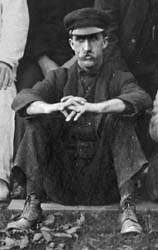 Charles Call c.
1903
Charles Call c.
1903
Basil and Stan on Charlie Call:
BW: My first recollections of Charlie was when he had the store on Main
Street which I think is the thrift shop today. Although the floor has been
dropped since Charlie owned it, because I remember right you went up two
or three steps to go into it. And Charlie had his store there, and he sold
stoves and plumbing supplies
SW:: He made a little money plumbing. He was in the plumbing business in
Edgartown when, I guess he was about the only plumber there in those days.
He made a lot of money down there.
BW: I think he did a lot of steam heat too, didn't he? Hot water or steam
or something?
SL: Yeah. A lot of heating jobs, yeah. And then he retired from plumbing
and he opened this store up here in Vineyard Haven.
BW: Yeah. Charlie had a couple of problems in life, I guess. I guess he
and his wife had a bitter separation, and she took everything he had. I
think that's when he lost his store and everything.
SL: Yeah, that's right.
BW: And then he kind of went on the skids. He became an alcoholic and he
was a real, well let's say bum, for awhile. Somebody got to him, I don't
know who, and he kind of saw the light. In his later years he used to,
God he got all cleaned up, and stopped drinking, and cleared up. He didn't
do anything, I guess he lived on his little old age pension or something
and he reacquired a lot of his self-respect again. Nice guy, I always liked
Charlie.
SL: Yeah, he was.
BW: Interesting to talk to.
Bob Renear bought toys in Calls store. He remembered: "Like a five and ten cent store, a small one. He was a little
bit of a character I think."
Sam Issokson said: "Charlie
Call, he had a hardware store or a gift store. I know he used to have games
in there. That was where the Thrift Shop is, or used to be. I used to go
in and look around. That's about all. I don't know whether he had very
much. The A&P moved in. They were there several years, 'till they got
to have a better place down that George Woods built for him."
Marge Taylor said: "I
remember the Call store. I think he had dishes and house wares, that type
of thing."
Charles F. Call died in April 1957 at the age of 79 at the State Hospital
in Taunton. His death record calls him a divorced plumber.
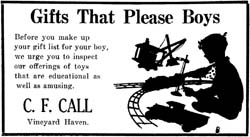 November 1929 ad
November 1929 ad
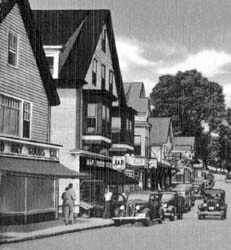 The A&P Grocery
Store (1938 - 1951)
The A&P Grocery
Store (1938 - 1951)
Stan Lair and Sid Counsell in conversation:
SL: What do you think about the supermarkets compared to the old grocery
stores? I mean, you used to have to go in with a list, read off one thing
at a time, the clerk would go all the way around, pick it up, come back...
SC: When we used to have the A&P down on Main Street there, you know,
we used to bring the list, I used to do the shopping, and bring the list.
That's right - you used to go, you'd say 'gimme a bread', they'd go get
the bread, 'gimme this', you know, they'd go get that. You give him the
list, and he'll do it, and put it in the box, while you're over to the
meat counter, you know, getting the meat off that guy over there. See?
SC: But some people would read off one thing at a time, and the clerk would
have to go way around the store to pick it up, come back...
SC: That's right!
SL: Today, of course, it's all self-service. I think it's a lot better.
You can pick out what you want.
In November 1937 Edward G. Cross of Hyannis sold the "Call
Block" to Mrs. George W. Cary. The Gazette announced that the
Atlantic and Pacific Tea Co. was planning to occupy the building
on May 1, 1938. The store was to be remodelled and repaired, and the floor
lowered to street level to eliminate the steps outside. The A&P had
been operating a branch store in Lane's Block across the street since at
least the spring of 1928. (See Site #4.) In December 1937 Art Rodgers
and Francis Howes were mentioned as working at the A&P. The new
A&P store opened at this location in the last week of April, 1938.
 Arthur E. "Art " Rodgers
(c.1910-11 - 1968) was born in Needham and evidently came to Vineyard Haven
in the early 1930s. He had reportedly worked for the A&P company since
1929, and worked at the Vineyard Haven A&P until about 1954. Afterwards
he became the manager of the produce department of Cronig Brothers (see
Site #33.)
Arthur E. "Art " Rodgers
(c.1910-11 - 1968) was born in Needham and evidently came to Vineyard Haven
in the early 1930s. He had reportedly worked for the A&P company since
1929, and worked at the Vineyard Haven A&P until about 1954. Afterwards
he became the manager of the produce department of Cronig Brothers (see
Site #33.)
Bob and Polly Renear on Arthur Rodgers:
PR: "When I remember him he worked in produce [in Cronigs], he was
so good."
BR: "I remember having a big argument with the man about yams and
sweet potatoes. He claimed they were the same thing, I said no, they're
different."
In September 1938 Roger Allen of Hyannis was named the new manager
of the Vineyard Haven A&P. In December 1941 John McCall was noted
as the meat manager, and Arthur Rodgers the grocery manager. By February
1942 William Luce was employed here. Chandler Lord (son of
Arthur B. Lord.) and Sterling Magee worked at the A&P during
the summer of 1942. Dana Swift, B. D. Crumlamb, and Ida Swartz
are remembered to have worked here, as well as Nonnie (Onnie?) White
who had formerly worked at Railway Express.
Connie (Frank) Iadicicco recalls:
"It was much less efficient than the First National. It was not a
very popular store. … It was laid out somewhat like the First National,
but it was bigger and barer. As you walk in the meat was in the back on
the right, and the grocery was on the left. There was very little in the
center."
In June 1942 the Martha's Vineyard National Bank foreclosed on the mortgage
held on this property by Elizabeth M. Cary. The bank assigned the title
to attorney Frank Vera of Dartmouth. In November 1943 Vera sold this
property to George A. Davis of Los Angeles under a trust in Lina
B. Call's name, and in March 1948 Davis sold the property to Leslie M.
and Florence L. Flanders of Tisbury. The Gazette reported in April
1948 that the "Call Block" had been sold by Mrs. Lina Call of
Edgartown to Mr. and Mrs. Leslie M. Flanders of Vineyard Haven. The building
was described then as containing the A&P store downstairs and two apartments
upstairs.
During the summer of 1948 Robert Howes (son of Theodore C. Howes
and grandson of Henry Howes of site #28)
worked at the A&P. In November 1951 Kiever McGee was reported
as working at here. Bill Wilkinson is also remembered as clerking
for the A&P.
In November 1951 the Gazette reported:
"George C. Woods, Vineyard Haven contractor, announced to the Gazette
on Wednesday, the signing of the lease of his new building on Water Street,
Vineyard Haven, by the Great Atlantic and Pacific Tea Company, which will
move from its present location as soon as it is completed and equipped.
Equipping of the new building will begin about Dec. 15. The new structure
is of masonry and steel construction throughout, and of a single story.
It contains 4,600 square feet of floor space and the single display window
on the front is 24 by 7 feet in area. Forced steam heat is to be installed
and the lighting is of the 'continuous strip' variety. The floor is of
asphalt tile and the fixtures and equipment will be the latest designs
in wood and metal. …Thirty-one working days has been consumed up to
and including Wednesday, since ground was first broken, which may not me
a record for the island but surpassed expectations."
"Leslie M. Flanders, owner of the Call Block, so-called,
now occupied by the A&P store, could give no information regarding
future occupancy of the building. The most he could say was that considerable
interest has been shown in the possibility of purchase or rental of the
building and he offered the opinion that it will not remain empty longer
than such period as may be necessary to re-equip the store."
The new A&P opened on Water street in February 1952, complete with
an "automatically operating exit door." The Gazette proclaimed
that it was "the nearest thing to a supermarket the Vineyard ever had
and quite the largest and most attractively appointed." The first purchase
was made by Walter C. Woods Jr., two-year-old grandson of builder George
Woods, who bought a loaf of bread and package of cereal. Arthur Rodgers
continued as manager at the new store.
In March 1952 Leslie and Florence Flanders announced the sale of the
Call Block to Anthony J. Oliver, proprietor of Vincent's Paper Store
(site #27), and his brother John J. Oliver
of New Bedford.
The Ken-Ward Store (1954)
During the summer of 1954, the Ken-Ward store was located here. In June
1954 they advertised themselves as a "gift and toy center."
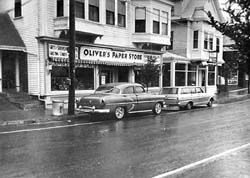 Oliver's Paper Store
and the Kitchen Shop, 1960s
Oliver's Paper Store
and the Kitchen Shop, 1960s
Oliver's Paper Store (1954 - c. 1973)
In November 1954 Anthony Oliver announced to the Gazette that
Vincent's Paper Store was moving into the Call Block, into what had been
the summer shop known as Ken-Ward. Anthony Oliver had bought the Vincent's
Paper Store business (Site #27) from Morton
Vincent in 1950. His new store opened here on December first. (Oliver announced
his plans to retain the old store building another year under his existing
lease and speculated that he might conduct a summer shop there.)
The new paper store was remodeled and decorated by the Smith Brothers,
contractors. The Gazette reported that "The wainscoting, five and a
half feet high, is of sheetrock, painted a light brown, and the counters
and shelving are of a slightly contrasting shade of the same color. Above
the wainscoting, the wall is of peg board, facilitating any sort of light
shelving or wall display, and this is of a light marine blue. The ceiling
is of acoustics material, and the floor is covered with linoleum."
Managing owner Anthony J. "Tony" Oliver (1901 - 1977)
was born in New Bedford, the son of John Oliver and Clara Mello of Pico
in the Azores. He came to the island in 1920 as a stationery salesman for
the F. S. Brightman Co. of New Bedford.
In May 1959 Oliver's advertised newspapers, magazines, stationery, gifts,
books, games, toys, and greeting cards.
In June 1963 they advertised newspapers, magazines, stationery, office supplies,
gifts, greeting cards, art supplies, and souvenirs.
In March 1973 the Oliver brothers sold this property to William C.
"Bill" Haynes of West Tisbury for $95,000.
Anthony Oliver retired in 1974 and died in September 1977.
Agnes Rice on Tony Oliver: "I
remember him. Pleasant enough guy. Kind of a tall, brown-haired, brown-eyed
guy. Quiet. He could be very funny with Paul Bangs, and Tom Rabbitt, and
Bill Carroll, I think at the time. He was pretty funny with those people.
Came from New Bedford. He used to work in that very popular store in New
Bedford that has all the writing equipment and stuff, Hutchinson's Bookstore.
That's where Oliver came from. He worked in Hutchinson's, and then he moved
down here."
 Detail from a pre-1973
postcard
Detail from a pre-1973
postcard
Haines' Gift Shop (1970s)
Bill Haynes ran a gift shop here for a few years during the mid-1970s.
In 1976 Bill Haynes sold this property to Lawrence M. "Larry"
Levine, son of Dave and Ida Levine of the Vineyard Dry Goods (see Site #29.)
The Thrift Shop (1970s - 2000)
The Thrift Shop was founded by Mrs. Edith Foote from West Tisbury, and
by the late-1970s had moved into this building from its former location
down the street (see Site #14.) It closed in 2000 and moved to a new location
on Lagoon Pond Road.
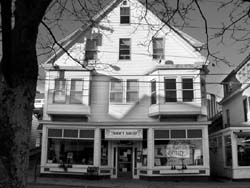 The
Thrift Shop, 2000
The
Thrift Shop, 2000
This is an unfinished draft! Do you have any memories of any of the
other people, places, businesses or events mentioned here? Or do you have
corrections, additions, or suggestions? Please contact Chris
Baer <cbaer@vineyard.net>
Return to Centre Street to Church
Street
Return to Tisbury History
 1891 illustration of
Eagleston's "Boston Store"
1891 illustration of
Eagleston's "Boston Store"





















 Charlie Call's China
Shop (1926 - 1937)
Charlie Call's China
Shop (1926 - 1937)






